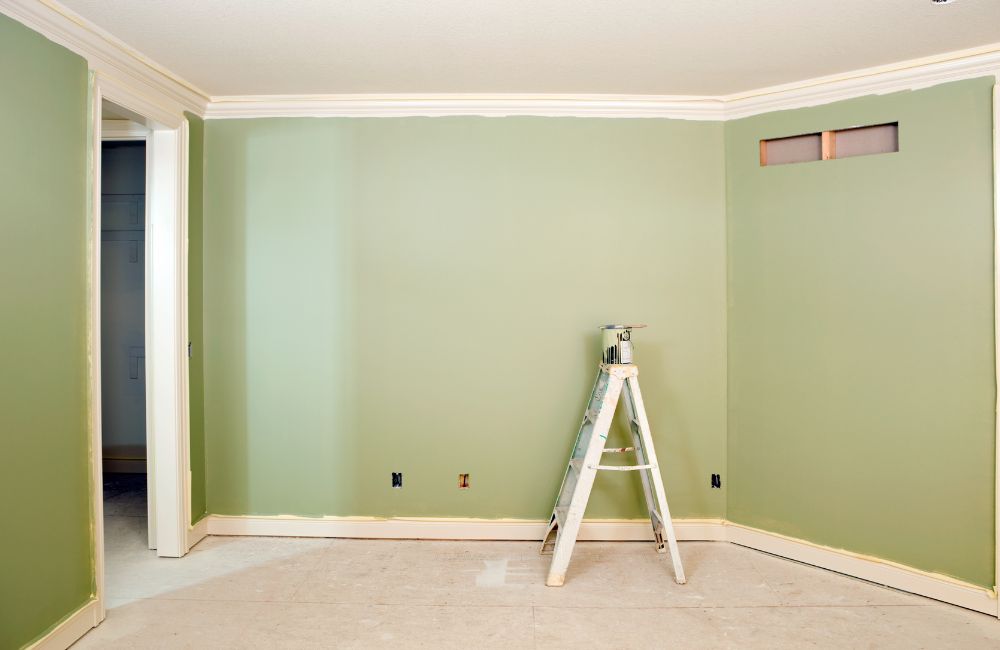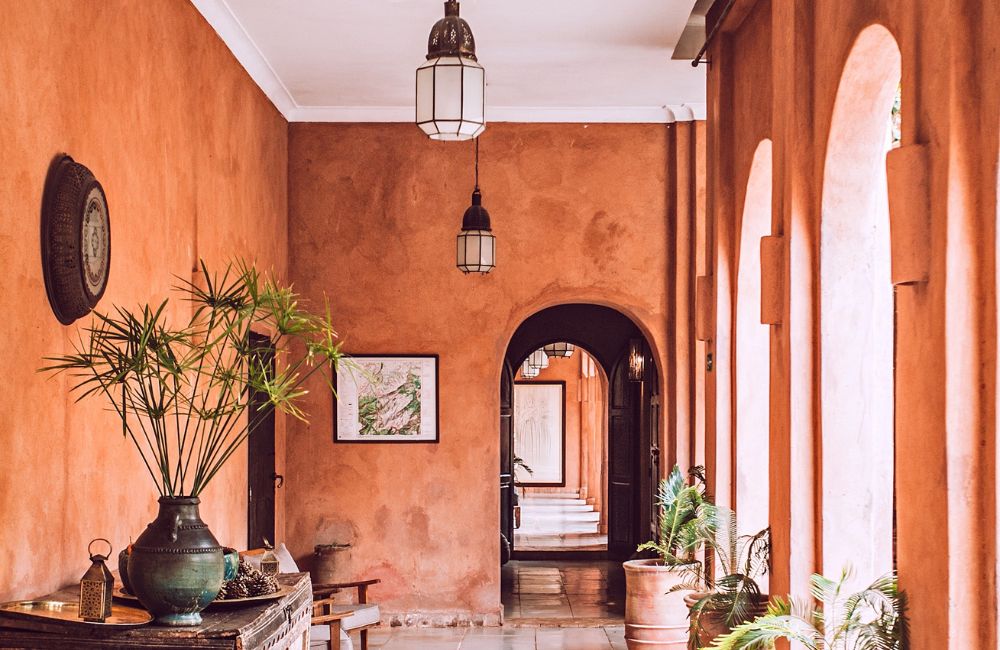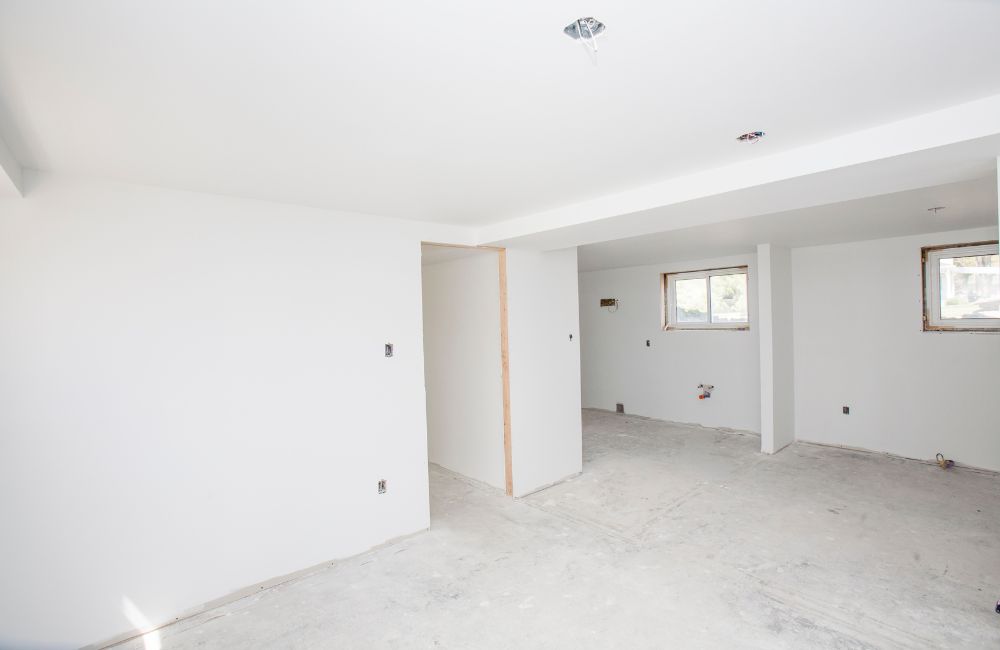Table of Contents
Key Takeaways
15 Recommended Colors for a Stunning Basement
1. Light Neutrals
2. Soft Whites
3. Warm Taupe
4. Soft Pastels
5. Navy Blue Accent Wall
6. Sage Green
7. Charcoal Gray
8. Soft Yellow
9. Light Blue-Grey
10. Earthy Browns
11. Terracotta or Clay
12. Dusty Rose
13. Muted Teal
14. Cool Greige
15. Bold Black Accent
Frequently Asked Questions
Transform Your Basement with Expert Painting in Westport, CT!
| Key Takeaways ✔ Light neutrals and soft whites brighten basements and create a welcoming, open feel. ✔ Warm taupe, earthy browns, and terracotta add cozy warmth, making basements feel grounded and inviting. ✔ Soft pastels, sage green, and dusty rose to introduce calm, subtle color, enhancing an airy, relaxing vibe. ✔ Bold choices like navy, charcoal gray, and black accents bring depth and a stylish modern edge. ✔ Versatile neutrals like cool greige and muted teal balance light reflection with sophistication, ideal for multipurpose spaces. |
In 2020, interior painting was the most popular home improvement project in the United States, with about 35% of homeowners choosing to refresh their indoor spaces with new colors. This trend reflects a growing interest in transforming interiors, particularly often-overlooked areas into more functional, inviting spaces. With the right color choice and expert interior painters in Westport, CT, even a basement can evolve from a storage zone into a lively extension of the home.
15 Recommended Colors for a Stunning Basement
Based on available data, for every $1,000 invested in basement refinishing, homeowners can expect to recoup around $700 in added value. Choosing the right colors maximizes this investment, as a well-designed basement can become a functional and stylish extension of the home.
Here are 15 color ideas recommended by interior painters to bring new life to basements, making them as stylish and welcoming as any other room:
1. Light Neutrals
Light neutral colors like beige, light gray, and cream are consistently recommended by interior painters for their versatility. In basements, where natural light is often minimal, these colors excel in brightening the area, creating a welcoming and open feel. Light neutrals reflect any available light, which amplifies brightness and prevents the space from feeling closed in. This effect is especially beneficial for basements with limited windows or low ceilings, as it enhances the perception of height and openness.
Popular Light Neutral Options:
- Beige: A warm tone that brings a cozy feel while remaining versatile.
- Light Gray: Adds a modern touch and complements various color schemes.
- Cream: Softens the space and pairs well with warm and cool accents.
2. Soft Whites
Soft whites, including pure and off-white shades, are highly effective for a clean and open look. Interior painters recommend these shades to maximize available light and contribute to a spacious feel often needed in lower-level areas. Soft whites work well in finished basements and multi-use spaces, as they provide a neutral backdrop that allows decor styles and accent colors to stand out without being overwhelming.
Top Soft White Choices:
- Pure White: For a fresh, modern look that reflects light exceptionally well.
- Ivory White: Adds a hint of warmth, balancing brightness with comfort.
- Antique White: Offers a touch of vintage charm while maintaining an airy feel.
3. Warm Taupe
Warm taupe brings depth and warmth without overpowering the room, making it an ideal choice for basement interiors. As a neutral color with brown or gray undertones, taupe adds a sophisticated, cozy feel to any space. Interior painters recommend taupe for its relaxed, inviting atmosphere, especially in entertainment rooms or multi-purpose spaces.
Recommended Warm Taupe Shades:
- Light Taupe: Keeps the space feeling open while adding subtle depth.
- Grayish Taupe: A chic option that pairs well with both modern and rustic decor.
- Brown Taupe: Warmer and cozier, ideal for basements with wood or natural accents.
4. Soft Pastels
Soft pastels are favored by interior painters for creating a balanced blend of color and calm in basement spaces. These gentle shades reflect light well in typically low-lit basement areas, creating an inviting, open feel without overpowering the room. By adding subtle hints of color, soft pastels contribute to an airy atmosphere that enhances comfort.
Key Shades to Consider:
- Light Blue: Adds a refreshing, oceanic feel, ideal for relaxed, serene spaces.
- Mint Green: Brings a soft touch of nature indoors, keeping the basement both calm and lively.
- Blush Pink: Adds warmth without being too bold, perfect for creating a cozy, yet refined atmosphere.
5. Navy Blue Accent Wall
Navy blue as an accent color creates a bold, dramatic effect that interior painters often recommend for basements. In basements with minimal natural light, navy accent walls also introduce depth, giving the room a stylish feel that suits both traditional and contemporary aesthetics.
Top Areas to Use Navy Blue Accents:
- Entertainment Nook: Adds a cinematic feel, ideal for media or game rooms.
- Fireplace Wall: Adds warmth and depth, making the area feel cozy.
- Reading Alcove: Defines space and offers a modern, intimate feel for quiet corners.

6. Sage Green
Interior painters often choose sage green for basements, as it balances warmth and sophistication with its earthy undertones. This color choice also suits a range of decor styles, from rustic to contemporary, adding a refreshing touch to basements with a relaxed or Scandinavian-inspired theme.
Ideal Uses for Sage Green in Basements:
- Home Office Area: as interior painters, this color promotes focus and relaxation, ideal for productive spaces.
- Guest Lounge: Adds a welcoming, fresh look for cozy seating areas.
- Hobby or Craft Space: Inspires creativity while keeping the room calm and stress-free.
7. Charcoal Gray
Charcoal gray is a go-to choice among interior painters for creating a modern, stylish look in basement spaces. Its depth adds a cozy, enclosed feel, making it ideal for larger, multi-functional areas. When paired with lighter accents, charcoal gray achieves a dramatic yet balanced contrast, which enhances the industrial or minimalist aesthetic that many interior painters recommend for basements.
Recommended Pairings:
- White or Cream Furniture: Light furniture contrasts beautifully with charcoal, keeping the space balanced and open. White or cream adds an airy feel that softens the room’s boldness.
- Metallic Accents: Brushed nickel, brass, or chrome accents offer a polished, industrial edge that interior painters often suggest for a sleek, elevated look.
- Natural Wood Elements: Wood tones add warmth, creating a welcoming atmosphere and softening the dark gray, which many interior painters favor for a balanced look.
8. Soft Yellow
Soft yellow is a warm, inviting shade highly recommended by interior painters for brightening basements with minimal natural light. This color creates a cheerful, open ambiance that is ideal for family rooms or play areas. Soft yellow’s cozy, uplifting effect counteracts any damp or confined feeling, making it perfect for homeowners looking to create a welcoming basement.
Complementary Design Elements:
- Light Wood Furniture: Adds warmth and enhances the natural feel, pairing beautifully with soft yellow. The light wood tones help keep the space airy and welcoming, a combination many interior painters favor.
- Neutral Rugs or Curtains: Soft neutrals balance the brightness of yellow, adding depth and texture. They ground the space without competing with the cheerful walls, which interior painters often recommend for family-friendly basements.
- Green or Blue Accents: Cool green or blue pops complement soft yellow and add a fresh, vibrant touch. These accents create a balanced and lively atmosphere.
9. Light Blue-Grey
Light blue-grey’s versatility complements various design themes, from coastal to modern minimalist. This color also suits multi-purpose spaces, offering a refreshing touch that doesn’t overwhelm. This color’s blue undertones subtly brighten low-light basements as well, making it perfect for home offices, guest rooms, or media rooms.
Best Design Pairings:
- White or Navy Accents: These colors can enhance a coastal or airy feel, complementing light blue-grey’s cool tones. They add crisp contrast in the interior, making the space feel brighter.
- Soft Textures: Pairing with plush rugs or pillows adds warmth and coziness, as it balances the cool tones. This combination is often used by interior painters for creating a comfortable, inviting ambiance.
- Natural Plants or Greenery: Greenery introduces freshness and a vibrant feel, enlivening the space. Interior painters note that it adds a natural, welcoming element to the calm backdrop.
10. Earthy Browns
Earthy browns, including shades like tan, mocha, and walnut, are top choices among interior painters for creating a rustic atmosphere in basement spaces. These shades bring a cozy warmth that works well in areas that may lack natural light. Interior painters often suggest these colors for their versatility across various basement functions, as their deep, natural hues lend a subtle elegance to the basement’s ambiance.
Best Uses for Earthy Browns in Basements:
- Media Rooms: Darker brown tones like mocha absorb light, creating an ideal environment for viewing screens.
- Home Bars or Game Rooms: Warm tan or walnut fosters a laid-back, rustic vibe that encourages relaxation.
- Guest Suites: Earthy browns pair well with other neutrals, making guest spaces feel inviting yet stylish.

11. Terracotta or Clay
With their warm, earthy reds and orange undertones, these terracotta and clay tones bring personality and energy to areas that can often feel drab or cold. Interior painters love these shades for their ability to add both character and a slight Mediterranean feel to any space. These shades evoke warmth and relaxation too—qualities that can transform a basement into a space where people want to linger.
Ideal Basement Spaces for Terracotta or Clay:
- Home Gyms: The vibrant energy of terracotta motivates and energizes without overwhelming the space.
- Reading Nooks or Study Areas: Clay tones create a comforting backdrop for focus and relaxation.
- Wine Cellars or Tasting Rooms: The earthy richness of terracotta lends a sophisticated, rustic charm.
12. Dusty Rose
Dusty rose, a soft, muted pinkish tone, adds a gentle warmth to basements that need a touch of sophistication and elegance. Its gentle undertones work well in multi-use spaces, as they add a refined and timeless feel. According to interior painters, this color also helps in making basements feel less stark and more inviting.
Best Uses for Dusty Rose in Basements:
- Home Offices or Study Spaces: Dusty rose provides a soothing backdrop, ideal for focus and creativity.
- Family Rooms or Play Areas: This soft shade can give family spaces a warm, stylish touch without being overly feminine.
- Guest Bedrooms: Dusty rose is soft and inviting, making it ideal for creating an elegant guest retreat.
13. Muted Teal
Muted teal is a unique yet versatile option often recommended by interior painters for homeowners seeking color without overwhelming boldness. With its subdued saturation, muted teal makes basements more vibrant while remaining grounded in its appeal.
Key Benefits of Muted Teal:
- Modern Appeal: Muted teal has a contemporary feel, which adds an updated, stylish look to basement spaces.
- Versatile Pairing: It pairs well with a range of colors, including grays, whites, and natural woods, making it easy to match with existing decor.
- Light Enhancement: Lighter versions of muted teal can reflect light better, enhancing the brightness of a basement space.
14. Cool Greige
Interior painters favor this blend for its inviting warmth paired with the sleek coolness of gray. Cool greige is highly adaptable, as it easily fits with decor themes from rustic to contemporary, making it an excellent flexible option.
Key Benefits of Cool Greige:
- Versatile Foundation: The adaptable nature of cool greige makes it easy to pair with both warm and cool tones in furniture and decor.
- Enhances Space Perception: Its light undertones can open up smaller basements, making the area feel larger and more inviting.
- Sophisticated Neutral: This shade’s neutrality lends a polished, modern look that feels both fresh and enduring.
15. Bold Black Accent
Adding bold black accents in a basement can dramatically elevate its look. Recommended by interior painters for walls, trims, or specific sections, black introduces depth, sophistication, and structure, particularly in larger basements.
Key Benefits of Bold Black Accents:
- Creates Visual Contrast: Bold black accents make other colors pop, enhancing the depth and dimension of the space.
- Modern and Elegant: Black is timeless and pairs effortlessly with contemporary or minimalist decor.
- Defines Spaces: In open-plan basements, black accents can help visually divide areas, adding definition without physical barriers.
Frequently Asked Questions
What kind of paint should I use for basement walls?
For basement walls, it’s best to choose a mold-resistant, waterproof paint designed specifically for high-moisture environments. Epoxy or latex paints are popular because they adhere well to concrete or masonry surfaces and can handle humid conditions. Look for paints labeled for basement or masonry use, as they often contain additives to resist mildew. If you’re dealing with raw concrete walls, a primer may be necessary to improve paint adhesion. Using a semi-gloss finish can also help make the walls easier to clean while reflecting more light in darker spaces.
How should I prepare my basement walls before painting?
Before painting basement walls, it’s crucial to address any moisture issues or leaks. Start by cleaning the walls thoroughly, removing dirt, dust, and any mold or mildew that might be present with a bleach solution or commercial cleaner. If the walls have existing paint, check for peeling and scrape it off, then sand down rough spots to create a smooth surface. Applying a primer, especially if working with concrete, can help the paint adhere better and last longer.
Do I need to worry about moisture when painting a basement?
Moisture is a major consideration when painting a basement. Basements often have higher humidity levels and can suffer from water seepage through the walls or floor. Address any significant water leaks or dampness issues before painting, as paint can peel or bubble when exposed to ongoing moisture. Waterproofing solutions, like sealants or waterproofing paint, can help if minor moisture is present. Installing a dehumidifier can also help maintain a dry environment, making the paint more durable over time.
Can I paint basement floors, and if so, what type of paint should I use?
You can paint basement floors, but using the right type of paint is essential for durability and moisture resistance. Epoxy or latex-based floor paints are commonly used, as they can handle foot traffic and are less likely to peel from humidity. Look for products labeled for concrete floors to ensure proper adhesion and longevity. Some people also add a non-slip additive to the paint to improve floor safety. Priming the floor before painting and ensuring it’s thoroughly clean and dry will also help achieve a smooth, lasting finish.
How can I maintain painted basement walls?
Maintaining painted basement walls is relatively simple but essential to keep them looking fresh. Clean the walls occasionally with a mild detergent to remove dust, dirt, or any mildew that might appear. If the walls become chipped or scratched, touch up those areas with matching paint to prevent further damage. For basements prone to moisture, monitor walls for any signs of bubbling or peeling paint, as these can indicate moisture issues that may require attention. Keeping the area well-ventilated with a dehumidifier can also help maintain the paint’s appearance over time.

Transform Your Basement with Expert Painting in Westport, CT!
Let Custom Colonial Painting bring new life to your basement with expert color selection and flawless finishes tailored to your unique style. Serving Westport, CT, we specialize in creating inviting, functional spaces that make your basement feel like an extension of your home. From brightening dark corners to adding modern accents, our professional painters deliver quality and precision in every project.
Rely on Custom Colonial Painting for a beautiful, lasting transformation right here in Westport, CT!



